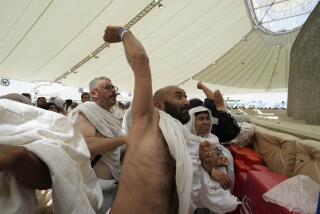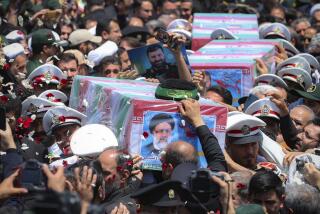Killings of Shiite Clerics Set Holy City of Najaf on Edge
- Share via
NAJAF, Iraq — Shiite clerics still make their rounds, pilgrims continue to pay homage, and street stalls conduct a vigorous business in Koranic pamphlets and posters of ayatollahs past.
But the veneer of tranquillity in this spiritual capital of the Shiite Muslim world is deceiving: A sense of insecurity and apprehension is prevalent in the wake of the car bombing outside the shrine of Imam Ali that killed 121 people, including esteemed cleric Ayatollah Mohammed Bakr Hakim.
“Certainly, Najaf is targeted,” said Mayor Haydar Mayali, a 36-year-old civil engineer deeply immersed in rebuilding tasks when the bombing on Aug. 29 shifted his focus almost completely to security. “Our clerics must be protected.”
In fact, Hakim’s assassination was only the latest in a string of attacks against religious figures since the ouster of Saddam Hussein. At least one other prominent cleric has been killed and several others targeted. Bodyguards with Kalashnikovs and walkie-talkies now cluster around well-known holy men, whose mobility has been severely limited.
Hussein loyalists are widely blamed in what some call a conspiracy to create bedlam in a city where religion is paramount. Such a plan, some theorize, is aimed at sowing dissension and chaos across Iraq and to pay back the Shiite leadership for cooperating with occupying U.S. forces. Hakim, who returned here following Hussein’s fall after more than 20 years in exile in Iran, was seen as a leading moderate inclined to work with the U.S.-led coalition.
“Many people have lost their privileges and are angry about it,” noted Mayor Mayali. “They do not want progress in Najaf.”
But, in the serpentine alleyways and smoky souks of this city 90 miles south of Baghdad there are also whispers of conspiracy and intrigue involving rival Shiite factions, Iranian spies, Arab radicals, saboteurs-for-hire and other potential culprits.
“People are nervous, and they wonder what might happen next,” said Saad Fakhir Deen, who runs a bookstore a block from the gold-domed shrine to Imam Ali, spiritual founder of the Shiite sect. “We have lived through a lot in Najaf, but the killing of our clerics is something we cannot tolerate.”
For U.S. authorities, the stakes could hardly be higher: A stable Najaf is essential to winning broad cooperation from Iraq’s Shiite majority, about 60% of the population. People here have grumbled about blackouts, water shortages and other problems that plague postwar Iraq. But things seemed to be progressing relatively smoothly in Najaf -- certainly compared with troubled cities like Fallouja and Ramadi in Iraq’s Sunni Triangle region, where attacks on U.S. troops are daily occurrences.
Najafis long repressed by the Hussein regime rejoiced over the strongman’s ouster and largely welcomed U.S. forces as liberators. Still fresh in the memories of many was the way Hussein’s Republican Guard ruthlessly put down the rebellion here after the Persian Gulf War of 1991.
Extraordinarily, Marines here have not registered a single attack specifically targeting U.S. forces since arriving in April, said Marine Maj. Rick Hall. One military policeman was killed, the major noted, but he was working with Iraqi police to break up a carjacking ring when firing broke out.
“One of our biggest problems is trying to combat complacency among our Marines because the people have been so good to us,” Hall said. “We have to keep in mind that there is a threat out there.”
Underscoring that threat, Hall said, was the arrest here last week of a 21-member cell of Baath Party loyalists planning attacks on coalition forces. Also detained last week was a Najaf police lieutenant allegedly tied to illegal sales of grenades and other weapons -- another troubling indication of corruption and possible split loyalties among an Iraqi police force that U.S. officials are relying on more and more to provide security.
The Marines were planning to turn over a stable Najaf to a Spanish-led force of Honduran and Salvadoran troops by Sept. 3. But then came the bombing.
“It would be wrong for the United States to leave Najaf so soon after a tragedy like that,” said Lt. Col. Chris Woodbridge, who heads the Marine battalion here.
Instead, U.S. and Iraqi authorities are working jointly to bolster a security apparatus that, in retrospect, was appallingly weak.
The bomb that took the lives of Hakim and 120 others was placed in a vehicle that was parked overnight outside the shrine’s ornately tiled southern portico, authorities say. Police noticed the car but never searched it -- even though Hakim, previously the target of death threats, was known to use that exit after presiding over Friday prayers. (A week earlier, a grand ayatollah related to Hakim survived a bomb attack that killed three bodyguards at his office near the shrine.)
While seeming a textbook terror attack, the bombing may actually have been an assassination timed at one of the few moments when the heavily guarded Hakim was vulnerable. Someone set off the remote- control bomb, fashioned with Soviet-era munitions, from a nearby hotel room, investigators theorize. The scores of worshipers and bystanders killed were probably collateral victims whose fate didn’t concern the conspirators, they said.
“This may have been something like a Mafia-type hit,” said one U.S. official familiar with the case, which is being investigated by the FBI. “A lot of innocent people got in the way, but the real target was Hakim.”
In the aftermath, Iraqi police and others harshly criticized occupation forces for shoddy security. Marines responded that they had kept clear of the shrine area at the insistence of clerics. That has changed.
U.S. and coalition forces now mount regular patrols near the shrine. A new, 400-member Iraqi police force has begun patrolling the shrine area. Law enforcement authorities have put up checkpoints on the main routes leading to and from the city and have closed streets near the shrine to vehicular traffic. Wary police are even conducting spot searches of the many coffins that arrive here daily as families seek to inter their loved ones in Najaf’s sacred ground.
“There is too much instability now: We must put an end to it,” Brig. Maithar Qaragholi, the Najaf police commander who heads the new force, said as he surveyed the shrine area from his white sedan a few hours before Friday prayers. “The people of Najaf cannot live with this sense of uncertainty.”
Officials here were quick to recite a laundry list of suspected groups: Hussein loyalists, foreign terrorists, fanatical Sunni Muslims who view the Shiite sect as heretical, among others. Officials have since downplayed reports that some suspects had ties to Al Qaeda.
Operatives from neighboring Iran are said to be another possible culprit. Infiltrators are widely believed to be entering Najaf with the many Iranian pilgrims flooding the city since Hussein’s downfall. The previous regime, ever wary of its longtime rival Iran, strictly limited the numbers of Iranian visitors and assigned secret police operatives to monitor them, residents say.
The Iranian regime, long a patron of Hakim, may have soured on his cooperative stance with the U.S. occupiers, according to this widely circulated theory. But no proof has emerged of Iranian complicity, and Tehran has condemned the attack.
A less repeated theory, and one usually mentioned only in hushed tones, is that the bombing and other attacks may have been the result of deep divisions within the secretive world of Shiite politics. This line of conjecture stems from an ongoing power struggle pitting a generation of younger, militant clerics against the aging, grand ayatollahs of Shiite learning -- imposing spiritual figures said to spend their days praying, studying the Koran and greeting occasional visitors to their spartan quarters.
The militants are said to resent the patient approach of their elders, and favor a quick transition to a theocratic state -- though they generally refrain from saying so publicly.
Leading the younger, more assertive clerics is Muqtader Sadr, the heavyset, perpetually scowling, black-turbaned progeny of a grand Shiite dynasty. Sadr, who says he is 30 but is widely believed to be in his 20s, has assailed the U.S. occupation and openly criticized Hakim before his death for not coming to the aid of Shiite rebels after the Gulf War. He has also dismissed as a puppet the U.S.-appointed Iraqi Governing Council, whose members include Hakim’s brother.
The Najaf-based Sadr has attracted a large following, mostly of young men in the major Shiite quarter of Baghdad, which residents renamed for his father in the wake of Hussein’s fall. In April, acolytes of the younger Sadr laid siege to the Najaf home of Iraq’s supreme Shiite authority, Grand Ayatollah Ali Sistani, and demanded he leave the country. That episode was soon defused.
This summer, Sadr accused U.S. authorities of surrounding his home and trying to arrest him -- an allegation denied by the Marines, who say the additional security was on hand because of a nearby visit by Paul D. Wolfowitz, the U.S. deputy secretary of defense.
Sadr’s upstart personality and provocative opinions have infuriated U.S. officials and have rocked a reclusive Shiite establishment that views him with thinly veiled disdain.
“He’s trying to make a name for himself with his constituency, which is young, disenfranchised, unemployed Shiites,” Woodbridge said. “He rants this extremist propaganda against this triad of evil -- the United States, Great Britain and Israel.”
Sadr was quick to denounce the killing of Hakim, and no one has accused him publicly of any involvement. Most observers here insist it is inconceivable that any Shiite faction would sanction an attack alongside one of the holiest Shiite shrines.
Still, Sadr was forced to deny publicly any connection with the killing of another cleric, Abdel Majid Khoei, who was slain in April inside the grounds of the shrine. Khoei, also the scion of a revered Shiite line, had just returned from exile in London.
Sadr has defied U.S. orders to disarm his personal militia, which he says is needed to guard holy places and clerics. During his Friday sermon to 5,000 worshipers at the ancient mosque in the neighboring suburb of Kufa, Sadr disparaged any reliance on U.S. forces for protection.
“The security issue is not to be left in the hands of the occupiers,” Sadr said, using an Arabic proverb akin to the old adage of not allowing the fox to guard the henhouse. “How can we rely on the enemy to protect us?”
As Sadr’s followers left the mosque and filed through the narrow streets of Kufa, Muiz Ali Maitham lamented the inability of the U.S. to stabilize Najaf and the rest of Iraq.
“Not long ago, I wanted to make a statue here of President Bush -- even bigger than Saddam’s statue,” said Maitham, 54, a retired city planner. “But now there’s no chance of that. Things had better improve soon.”
*
Raheem Salman of The Times’ Baghdad Bureau contributed to this report from Najaf.
--- UNPUBLISHED NOTE ---
In stories after April 9, 2004, Shiite cleric Muqtader Sadr is correctly referred to as Muqtada Sadr.
--- END NOTE ---
More to Read
Sign up for Essential California
The most important California stories and recommendations in your inbox every morning.
You may occasionally receive promotional content from the Los Angeles Times.













